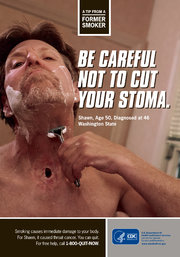Source: www.nytimes.com
Author: Andrew Adam Newman
Telling smokers that their habit shortens life expectancy by at least 10 years might seem like an effective way to get them to quit. But it turns out there is something even scarier: living with disfiguring disease.
Dr. Tim McAfee, the director of the Office on Smoking and Health at the Centers for Disease Control and Prevention, was overseeing focus groups of smokers to help shape a smoking-cessation advertising campaign in 2011 when this became clear.
“Telling smokers that you’re going to lose 11 to 12 years of your life expectancy if you continue to smoke, and that if you quit in your 30s you can gain 10 of those back, seemed pretty powerfully motivating to us,” said Dr. McAfee.
But smokers’ response to such messages was that it would not happen to them, Dr. McAfee said. What they feared more than an untimely death, it turned out, was chronic illness.
“They were less motivated by the fear of dying than the fear of suffering, of disability, of disfigurement, and of being a burden to those around them,” Dr. McAfee said.
Introduced in 2012, the C.D.C. campaign, “Tips From Former Smokers,” by Arnold Worldwide in Boston, features people who did not quit until smoking had taken a grave toll. The ads ostensibly offer practical advice about how to function with smoking-related ailments, but the real message is to avoid such predicaments by kicking the habit.
A new series of commercials includes one featuring Shawn Wright, a chef who lives in Spokane, Wash., who was 50 at the time it was shot. Mr. Wright, who started smoking at around age 14 and had a pack-and-a-half-a-day habit, lost his larynx to throat cancer in his late 40s and now has a dime-size stoma, a hole in his throat.
The commercial opens with a title card, “Tips from a former smoker,” and Mr. Wright in the shower, the water running behind him. Mr. Wright, who has a voice prosthesis implanted in his throat and must cover his stoma with a finger to speak, says with a gravelly voice, “When you have a hole in your neck, don’t face the shower head.” He is also filmed pushing a lawn mower (“Keep the stoma covered when you’re outside”) and sitting at a dining room table (“Get used to eating only soft foods”).
At the close of the spot, as he looks in a mirror, he sticks a tool with a brush on the end into the hole in his neck, saying, “Clean out your speech valve twice a day.”
Another new commercial features Amanda Brenden, of Eau Claire, Wis., who attributes smoking throughout her first pregnancy to her daughter’s being born two months prematurely and weighing only three pounds.
In the commercial, she demonstrates how she could not hold her newborn daughter, who was confined to a neonatal incubator. As she opens a small oval door on the incubator, tears well in her eyes. “My tip to you,” she says, “is speak into the opening so your baby can hear you better.”
Public service announcements generally rely on donated ad space, and they run infrequently and during programming with lower viewership. But the federal effort gets its funding through the Affordable Care Act, with the C.D.C. spending a total of $102.5 million to produce and place the ads in 2012 and 2013, and it is budgeted to spend an additional $60.2 million this year.
Kenneth E. Warner, a public health professor at the University of Michigan and founder of the university’s Tobacco Research Network, said funding made a big difference in the success of antismoking campaigns.
“Campaigns that are mounted by an organization that is paying for them are hugely different from other P.S.A.s, which typically rely on donated ad space and get very little time and not much coverage,” Mr. Warner said. His research suggests that well-funded antismoking campaigns are the third-most-effective measure for reducing smoking levels, behind high cigarette taxes and laws against smoking in certain places.
The 2012 C.D.C. campaign was the subject of a 2013 article in The Lancet, which credited the ads with motivating 1.6 million smokers to try to quit — with more than 100,000 of them successfully doing so. The telephone number promoted in the campaign, 1-800-QUIT-NOW, received about 365,000 calls during the 12 weeks that the ads ran in 2012, more than twice the number of calls in the same period of 2011.
To date, the campaign has featured 26 people, including a few nonsmokers who had asthma attacks because of secondhand smoke. Some of the smokers had conditions like Buerger’s disease, which may result in the amputation of limbs and extremities; oral and lung cancer; and gum disease that resulted in the loss of most or all of their teeth.
One subject of the ads, Terrie Hall, who was first featured in 2012, appeared in another ad in 2013 as her throat cancer spread to her brain. She died in September 2013, at age 53. Graphic commercials and online videos featuring Ms. Hall, who is featured posthumously in the current ads, have been viewed more than 5.5 million times on YouTube.
Mr. Wright, the throat cancer survivor shown in current ads, was filmed in 2012, when he was featured in an ad that included others with stomas, but this year marks the first time he appears solo.
Now 53, Mr. Wright said it could be difficult to watch himself in the ad.
“When I see myself in a compromising position, it does get to me a little bit,” he said. “But if people see me and know a little bit about my story, they might have second thoughts about even starting to smoke, and you just put your modesty aside when you’re doing the right thing.”


Leave A Comment
You must be logged in to post a comment.